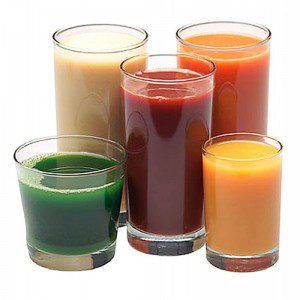Contributing writer for Wake Up World
I believe America is the “land of extremes”. As far as health and nutrition, here you can find the worst, mutilated lab made food one can possibly think of, as you will find a big variety of very nutritious, healthy food that was grown in perfect and sustainable conditions, with lots of care.
Going from one extreme to another, here we also find an actual trend where people that indulged in junk food, toxic meats that came from factory animals, and over-medication, desperately feel the need to “detox”, to do something for their health, and so load on veggie-fruit juices every day. Around gyms you can see now people lining up at cafes for a “green smoothie” after workout, just to continue with another one when they get home, instead of dinner.
I often have clients that hit the “GAS” pedal of juice-making to the ground and are very surprised when I tell them to stop… And yes, “gas” has something to do with it, but there is much more than that! Here are the main issues:
1. One Juice Doesn’t Fit All
As proved by the Metabolic Typing ® concept, concentrated fruits and vegetables in the form of juice, are not well-tolerated by protein types like Parasympathetics and Fast Oxidizers, due to the high potassium content. On the other hand, in carbohydrate metabolic types (like Slow Oxidizers), juicing can be beneficial, especially when used along with a correct diet which nourishes the metabolism. This is why many serious diseases like cancer were successfully treated with intense juicing in certain metabolisms, while they dramatically failed in others.
But then, as taught by the Metabolic Typing ® methodology, we know that finding the right juice for the right body doesn’t stop here! We also have Mixed and Balanced types, that need to eat a variety of foods in a certain combination, in order to get maximum efficiency and thrive! Yes, just throwing fruits and veggies in a blender or juicer, can completely disturb and confuse the cells of such metabolisms!
The effects of nutrition are both absolute and cumulative. So potassium will definitely stimulate certain metabolisms and increases their oxidation rate, regardless of how one feels or reacts when consumption is begun. And over time, the cumulative impact would grow stronger … and stronger. What initially might be experienced as “no impact”, in time could yield increased appetite, sweet cravings, blood sugar fluctuation, lethargy, hyperactivity, anxiety, nervousness, energy loss, depression, aching joints, etc. – and never be connected to the use of the juice since symptoms wouldn’t necessarily manifest until weeks later.
On top of that, a large number of people have very poor digestion these days. Although theoretically nutritious and high in enzyme content, raw juices and veggies can further irritate the gastrointestinal system and generate more damage than good. If symptoms like flatulence, bloating, burping occur, you might have an idea of how the juice affects your digestion.
2. Thyroid Problems? It Might Be Your Juice!
There are more than 13 millions people that suffer from low thyroid function (hypothyroidism) in US and this number is growing, due to improper diet, stress, and incorrect treatment that fails to address and determine the real cause behind it.
Cruciferous vegetables like broccoli, cauliflower, Brussels sprouts, cabbage, kale, mustard greens, spinach, radishes, turnips, arugula, bok choy, collard greens, rutabaga, watercress, even pears and peaches all contain substances called goitrogens, which suppress thyroid function.
Cooking crucifers reduces the goitrogenic substances by about 2/3. Fermentation does not reduce goitrogens, so fermented crucifers such as sauerkraut should be eaten in moderation.
Many of these vegetables are commonly included in fresh veggie juice blends or in salads. Moderation here is key, especially when you know you might suffer from hormonal imbalances (that mostly affect thyroid function as well) and you know your metabolism can’t thrive on such concentrated juices.
3. Oxalic Acid And Mineral Absorption
Oxalic acid occurs naturally in quite a large number of plants and can combine with calcium and iron, forming less soluble salts known as oxalates. As a result, foods high in oxalic acid, by lowering calcium in the body, can worsen the imbalance of protein types like Parasympathetics and Fast Oxidizers, who are already low on calcium.
High oxalic acid foods are chocolate, cocoa, coffee, most berries (especially strawberries and cranberries), beet greens, bell peppers, currants, endive, grapes, parsley, plums, mustard greens, rhubarb, Swiss chard, summer squash, sweet potatoes, and tea.
So eating raw spinach regularly and worse, when used daily in juicing, can interfere with mineral absorption and irritate the intestines. The good news is that by light cooking or steaming you can reduce the oxalic acid and still benefit from the nutrients that these foods offer.
4. Is Juicing Right For You?
With all these being said, one wonders if it’s better to totally ditch juicing after all? Of course not! There are many situations where we have to choose wisely our foods, supplements and health advisers, if we want to reverse illness and metabolic imbalances. The matter of “juicing” is such a “situation” as well. And to find the answer that is right for you and your metabolism only, I suggest to find out your metabolic type and discover if your existent mineral and hormonal imbalances can be worsened by juicing or not.
5. Different Juicing Recipes For Different Metabolisms
To further prove that there IS hope for avid juicers, also consider this: once you know your metabolic type, you will also be able to purchase a cookbook, which is especially designed for your unique metabolism, with delicious recipes that won’t leave you hungry, but feed your cells instead with what they really need. These cookbooks have been developed by one of my mentors and gourmet chef, Nancy Dale, CN and can be a great help when trying to adjust to a new way of eating.
To give you an idea of how differently should juices be customized for different functioning metabolisms, I’m writing below two of Nancy Dale’s recipes for juicing, one for a carb type and one for a protein type. You will notice there ingredients like “raw spinach and cabbage”, but keep in mind: moderation and customization!
Nancy’s Juice for Carbohydrate Types
|
1 |
Green Power – Make sure you use only organic vegetables. Rinse and cut in small enough pieces to place in juicer. | 1-2 C. arugula leaves, 1 cucumber, 1 zucchini, 1 carrot, ½ lemon |
| 2 | Ginger Blaster – Use only organic vegetables and fruits. Rinse and cut in small pieces to fit in juicer. | 1-2 inches ginger root, peeled, 1-2 C. kale leaves, 1 C. cabbage leaves, 1 cucumber, 1 apple, cored and quartered, ½ lemon |
| 3 | Pink Lady – Use only organic vegetables and fruits. Cut into small enough pieces to fit in juicer. | 1-2 C. loose leaf lettuce, 1 cucumber, ½ C. parsley, ½ beet, ½ lemon |
| 4 | Puerto Rican Cabbage Drink – Use only organic vegetables. Rinse and cut into small enough pieces to fit into juicer. | 2 C. cabbage leaves, ½ C. carrots, 2 T. onion, 2 T. cilantro, ¼ lime, ½ T. Bragg’s Amino Acid (soy sauce) |
Tip: Triple recipes and juice once for all three meals and store in a glass container for the other meals. Drink first before eating for best results, or may drink in between as a pick-me-up.
Nancy’s Juice for Protein Types
|
1 |
Sweet Beginnings – Wash ingredients. Use organic when possible. Juice add cream, stir and serve. | 2 carrots, ½ apple, ¼ medium beet, 1 celery stalk, ½ C. raw cream or coconut milk |
| 2 | Fall V-8 – Wash ingredients. Use organic when possible. Juice, add cream stir and serve. | 1 parsnip, 1 C. Jerusalem artichokes, 1 C. kale leaves,2 stalks celery, 1 C. spinach, ½ C. raw cream or coconut milk |
| 3 | Sweetheart – Wash ingredients. Use organic when possible. Juice add cream, stir and serve. | 3 carrots, 1 apple, ½ small beet, ½ C. raw cream or coconut milk |
| 4 | Greenie – Wash ingredients. Use organic when possible. Juice, add cream, stir and serve. | ¼ C. cabbage, 2 stalks celery, 1 C. fennel, ¼ C. raw creamor coconut milk |
| 5 | Pink Lady – Wash ingredients.Use organic when possible. Juice, add cream, stir and serve. | 1 red apple, 3 celery stalks, ½ medium cucumber,5 lettuce leaves (bibb), ½ C. raw cream or coconut milk |
Tip: May add a raw egg to any of these for added protein or make sure you eat your primary protein before drinking any of these juices.
Enjoy!… If you know your Metabolic Type! 🙂
Article Sources:
Recommended articles by Raluca Schachter:
- Vitamin D Supplementation: This is Why It Can Be Wrong
- Hypothyroidism or Hashimoto’s? What You Need to Know and Why It Matters
- Understanding Cannabis Oil
- 6 Steps to Solve Your Blood Sugar Problems Permanently
- Antibiotic Resistant Infections: The Dangers… and How You Can Avoid Them
- What Really Happens When You Take Antibiotics?
- Understanding Inflammation and How to Eliminate It Naturally
- Listen to Your Body. Correct Food Ratios. Reverse Disease.
- Cholesterol Myths Debunked
- Follow The Money In “Sick-Care”: What’s Behind The Drugs And Needles?
- What Happens In Your Body When You Suffer From Thyroid Disease?
About the author:
 Raluca Schachter is a dedicated Clinical Nutritionist / Natural Health Practitioner a.k.a “The Health Detective”. Raluca was able to naturally reverse chronic health conditions she was struggling with most of her life, and now uses her knowledge to help as many people as possible do the same. Her health programs and diet plans offer a very unique and comprehensive approach to health, where individual nutritional and biochemical requirements are firstly met using specific nutrients and foods that each metabolism thrives on. Raluca offers her services to international clientele and her practice is fully online based. You can connect with Raluca at www.metabolicenergy.net and https://www.facebook.com/raluca.schachter.metabolicenergy
Raluca Schachter is a dedicated Clinical Nutritionist / Natural Health Practitioner a.k.a “The Health Detective”. Raluca was able to naturally reverse chronic health conditions she was struggling with most of her life, and now uses her knowledge to help as many people as possible do the same. Her health programs and diet plans offer a very unique and comprehensive approach to health, where individual nutritional and biochemical requirements are firstly met using specific nutrients and foods that each metabolism thrives on. Raluca offers her services to international clientele and her practice is fully online based. You can connect with Raluca at www.metabolicenergy.net and https://www.facebook.com/raluca.schachter.metabolicenergy

If you've ever found value in our articles, we'd greatly appreciate your support by purchasing Mindful Meditation Techniques for Kids - A Practical Guide for Adults to Empower Kids with the Gift of Inner Peace and Resilience for Life.
In the spirit of mindfulness, we encourage you to choose the paperback version. Delve into its pages away from screen glare and notifications, allowing yourself to fully immerse in the transformative practices within. The physical book enriches the learning process and serves as a tangible commitment to mindfulness, easily shared among family and friends.
Over the past few years, Wake Up World has faced significant online censorship, impacting our financial ability to stay online. Instead of soliciting donations, we're exploring win-win solutions with our readers to remain financially viable. Moving into book publishing, we hope to secure ongoing funds to continue our mission. With over 8,500 articles published in the past 13 years, we are committed to keeping our content free and accessible to everyone, without resorting to a paywall.







